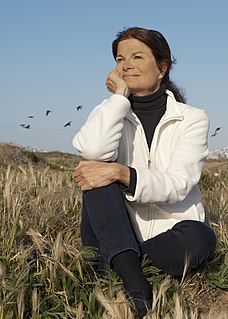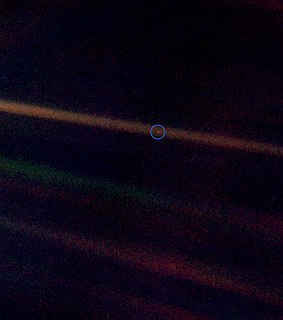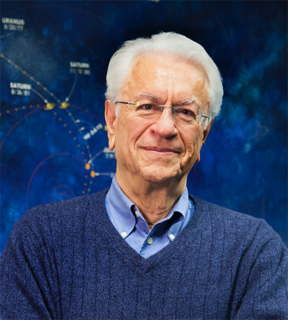
The Cassini–Huygens space-research mission, commonly called Cassini, involved a collaboration among NASA, the European Space Agency (ESA), and the Italian Space Agency (ASI) to send a space probe to study the planet Saturn and its system, including its rings and natural satellites. The Flagship-class robotic spacecraft comprised both NASA's Cassini space probe and ESA's Huygens lander, which landed on Saturn's largest moon, Titan. Cassini was the fourth space probe to visit Saturn and the first to enter its orbit, where it stayed from 2004 to 2017. The two craft took their names from the astronomers Giovanni Cassini and Christiaan Huygens.

Huygens was an atmospheric entry robotic space probe that landed successfully on Saturn's moon Titan in 2005. Built and operated by the European Space Agency (ESA), launched by NASA, it was part of the Cassini–Huygens mission and became the first spacecraft to land on Titan and the farthest landing from Earth a spacecraft has ever made. The probe was named after the 17th-century Dutch astronomer Christiaan Huygens, who discovered Titan in 1655.

Carolyn C. Porco is an American planetary scientist who explores the outer Solar System, beginning with her imaging work on the Voyager missions to Jupiter, Saturn, Uranus and Neptune in the 1980s. She led the imaging science team on the Cassini mission in orbit around Saturn. She is an expert on planetary rings and the Saturnian moon, Enceladus.

The European Space Astronomy Centre (ESAC) near Madrid in Spain is the ESA's centre for space science. It hosts the science operation centres for all ESA astronomy and planetary missions together with their scientific archives. Past and present missions represented at ESAC include Akari, BepiColombo, Cassini–Huygens, Cluster, Exomars, Gaia, Herschel, Hubble, ISO, INTEGRAL, IUE, LISA Pathfinder, Mars Express, Planck, Rosetta, SOHO, Solar Orbiter, Venus Express, and XMM-Newton.

The Lunar and Planetary Laboratory (LPL) is a research center for planetary science located in Tucson, Arizona. It is also a graduate school, constituting the Department of Planetary Sciences at the University of Arizona. LPL is one of the world's largest programs dedicated exclusively to planetary science in a university setting. The Lunar and Planetary Lab collection is held at the University of Arizona Special Collections Library.

The Astrogeology Science Center is the entity within the United States Geological Survey concerned with the study of planetary geology and planetary cartography. It is housed in the Shoemaker Building in Flagstaff, Arizona. The Center was established in 1963 by Eugene Merle Shoemaker to provide lunar geologic mapping and to assist in training astronauts destined for the Moon as part of the Apollo program.

The Space Science Institute (SSI) in Boulder, Colorado, is a nonprofit, public-benefit corporation formed in 1992. Its purpose is to create and maintain an environment where scientific research and education programs can flourish in an integrated fashion. SSI is among the four non-profit institutes in the US cited in a 2007 report by Nature, including Southwest Research Institute, Planetary Science Institute, and Eureka Scientific, which manage federal grants for non-tenure-track astronomers.

The Space Research Centre is an interdisciplinary research institute of the Polish Academy of Sciences. It was established in 1977. SRC PAS is the only institute in Poland whose activity is fully dedicated to the research of terrestrial space, the Solar System and the Earth using space technology and satellite techniques.

Discovery and exploration of the Solar System is observation, visitation, and increase in knowledge and understanding of Earth's "cosmic neighborhood". This includes the Sun, Earth and the Moon, the major planets Mercury, Venus, Mars, Jupiter, Saturn, Uranus, and Neptune, their satellites, as well as smaller bodies including comets, asteroids, and dust.

Charles Kohlhase worked for forty years at NASA/JPL leading the design of several robotic deep-space planetary missions. He is also an author, game developer and lecturer.

Stamatios (Tom) M. Krimigis is a Greek-American scientist in space exploration. He has contributed to many of the United States' unmanned space exploration programs of the Solar System and beyond. He has contributed to exploration missions to almost every planet of the Solar System. In 1999, the International Astronomical Union named the asteroid 8323 Krimigis in his honor.

David John Southwood is a British space scientist who holds the post of Senior Research Investigator at Imperial College London. He was the President of the Royal Astronomical Society from 2012–2014, and earlier served as the Director of Science and Robotic Exploration at the European Space Agency (2001–2011). Southwood's research interests have been in solar–terrestrial physics and planetary science, particularly magnetospheres. He built the magnetic field instrument for the Cassini Saturn orbiter.
Bonnie J. Buratti is an American planetary scientist in the Division of Earth and Space Sciences at the Jet Propulsion Laboratory in Pasadena, California, where she leads the Comets, Asteroids, and Satellites Group. Her research involves the composition and physical properties of planetary surfaces, and volatile transport in the outer solar system.

A flyby is a spaceflight operation in which a spacecraft passes in proximity to another body, usually a target of its space exploration mission and/or a source of a gravity assist to impel it towards another target. Spacecraft which are specifically designed for this purpose are known as flyby spacecraft, although the term has also been used in regard to asteroid flybys of Earth for example. Important parameters are the time and distance of closest approach.

Athena Coustenis is an astrophysicist specializing in planetology. Dr. Coustenis, a French national, is director of research, Centre national de la recherche scientifique, at LESIA, at the Paris Observatory, Meudon. She is involved in several space mission projects for the European Space Agency (ESA) and for NASA. Her focus is on gas giant planets Saturn, Jupiter and their moons, and she is considered a foremost expert on Saturn's moon Titan.

The Science Programme of the European Space Agency is a long-term programme of space science and space exploration missions. Managed by the agency's Directorate of Science, The programme funds the development, launch, and operation of missions led by European space agencies and institutions through generational campaigns. Horizon 2000, the programme's first campaign, facilitated the development of eight missions between 1985 and 1995 including four "cornerstone missions" – SOHO and Cluster II, XMM-Newton, Rosetta, and Herschel. Horizon 2000 Plus, the programme's second campaign, facilitated the development of Gaia, LISA Pathfinder, and BepiColombo between 1995 and 2005. The programme's current campaign since 2005, Cosmic Vision, has so far funded the development of ten missions including three flagship missions, JUICE, Athena, and LISA. The programme's upcoming fourth campaign, Voyage 2050, is currently being drafted. Collaboration with agencies and institutions outside of Europe occasionally occur in the Science Programme, including a collaboration with NASA on Cassini–Huygens and the CNSA on SMILE.

Sushil K. Atreya is a planetary scientist, educator, and researcher. Atreya is a professor of Climate and Space Sciences and Engineering at the University of Michigan, Ann Arbor.















